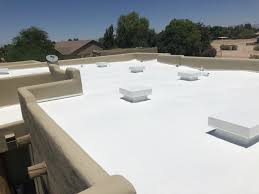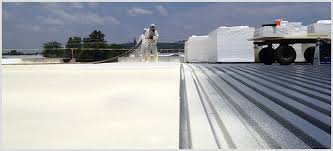What is foam roofing?
Polyurethane foam has been used as a roofing material for almost 50 years. Made from a combination of isocyanat and polyol, the foam is mixed together in a sprayer and applied to the roof surface as a liquid. The foam then begins to bubble up and expand, reaching into and sealing all the cracks and crevices in the roof. The roofing installation team will then apply a durable outer layer to protect the foam from the elements.
Foam is especially good at the following:
- Preventing heat transfer: In the summers here in Phoenix, that means that foam does a good job insulating your home and preventing heat from getting into the living spaces of your home.
- Preventing moisture: Because foam expands to fill up even the smallest of cracks, it’s good at preventing rain and moisture from getting to the roof it self.

Foam roof fix made easy
Once the older foam has been removed the damaged inherent deck will get visible and you must appropriate fixes and stains to it. Before applying new foam, you need to guarantee the repairs are still clean.
By obeying instruction you should re-foam the area having a high-density foam repair kit (2.5 to 4 lbs. density). Employ foam after putting on some disposable gloves and attaching the nozzle to foam container and the applicator. The applicator will vary based on the apparel. The valve can be turned on after this. As the foam will dry quickly in only a few moments you will need to work immediately. The extra foam might be wiped off using rags.

What are the benefits of foam roofing?
Here are just some of the ways in which you can benefit from installing foam roofing on your roof.
1. Lower energy bills
One of the benefits of foam roofing is that it offers superior insulation properties. The suspended aluminum particles of the foam reflect UV rays. As a result, less heating is required to keep the house warm during the winters, and less cooling is needed in the summer to keep your home cool. This effectively reduces your home energy bills.
2. Waterproofing qualities
Another benefit of installing foam is that it offers unique waterproofing qualities. Polyurethane foam is one of the best insulators. The closed cell foam is the only insulating material that doesn’t soak up water. This makes foam roofing ideal for areas that receive high rainfall every year.
At first glance, it might not seem that Phoenix fits that description. However, consider our monsoon storms, which can drop a tremendous amount of rain in a matter of minutes. One of the benefits of foam roofing is that it’s waterproof against such torrential downpours like those seen during our Arizona monsoon season.
Foam is applied as a liquid that forms into a single monolithic membrane. This material covers the entire roof, and there are no joints or seams. Water gets in from the joints and seams of the ceiling. Therefore, foam roofing makes the roof effectively leakproof.
3. Flexible installation
Foam can be applied on both existing and new roofing projects. Moreover, it can be applied on different types of roofs, including domed, pitched, flat, wood, metal, and concrete roofing. Foam can also be applied on irregular-shaped roofs. It eliminates the need of costly tear-off in case of roof replacement.
4. Maintain structural integrity
Polyurethane foam has the ability to withstand the expansion and contraction of the structure. They can remain sealed to the roof for a very long time, protecting the roof from harsh weather conditions. Foam can easily withstand high winds, sunshine, rain, and other natural elements here in central Arizona without breaking down. Finally, foam roofs are fire resistant.
5. Foam roofing directs rain to the drain
One of the benefits of foam roofing is that it allows rainwater to slope down to the drains. This is made possible by adding a little thickness in low areas. In this way, “flat roof” is actually a bit of a misnomer: there’s a slight slope that allows rainwater to come off of the roof and get into the gutters.

Cons Of Spf Roofs
Not All Contractors are Created Equally
The application of the spray foam is a process that needs to be done correctly from the beginning. The contractor needs to be precise with the application and have a solid understanding of the chemicals they are using.
It doesn’t take a large crew to install an SPF roofing system, but it requires a high degree of technical knowledge and experience.
The Spray Polyurethane Foam Alliance (SPFA) has an ISO-17024 compliant certification program that has multiple levels, requires the contractor to pass an exam and meet the criteria for a certification.
If the roofing system is installed incorrectly, it can be detrimental to the lifespan of the roof and underlying substrate.
Reasons You Should Choose Foam Roofing for Your Next New Roof
If the time is approaching for you to replace the roof commercial building, there are options for you to consider. One you might want to think about using is a sprayed foam roof. There are a number of benefits to using this type of roofing.
Quick and easy installation
A roofing job on a large commercial building using traditional roofing materials such as steel or aluminum can take several days depending on the size of the structure. However, most buildings can have a sprayed-on foam roof applied in one day. The application process also requires fewer workers and is safer than traditional roofing process, which means less likelihood of any accidents or workers going down with heat-related problems.
Energy-efficient
Spray foam roofing is among the most energy-efficient roofing processes there is. The spray foam acts as insulation, keeping the heat out and the cool in during the hot Arizona summers. Studies have shown that spray foam roofing can cut energy costs by up to 30 percent.
Long-lasting
Another benefit of spray foam roofing is that it lasts a lot longer than most conventional roofing materials, as long as you maintain it properly. With periodic reapplications, foam roofing can last 50 years or more, whereas most other roofs using other types of materials usually only last 20-30 years.
Water-resistant
Spray foam roofs are seamless and have no breaks where water can find a place to get in. Such roofs also use special sealants that make it pretty much impossible for water to penetrate the surface. With traditional roofing, water infiltration is an issue anytime there is damage or as the roof degrades over time.
Environmentally friendly
Spray foam roofing is better for the environment than other types of roofing. Many types of roofing have asphalt in them, which is a petroleum-based material. Conventional roofing also has several layers, which means there is more waste generated. Neither of those things is an issue with spray foam. Spray foam roofing also uses no chlorofluorocarbons and has a very low amount of volatile organic compounds.



